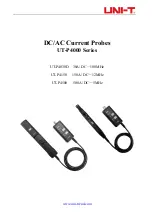
9
measured. The facing surface of the core section can be scratched while it is open.
Do not place any un-clamped conductor with an electric current of a frequency of 10 kHz
or more near the sensor head. Current flowing in the conductor nearby may heat up the
sensor head and cause its temperature to rise, leading to damage to the sensor. For
example, when one side of a go-and-return conductor is clamped and the other side is also
placed near the sensor head , even if the electric current is lower than the consecutive
maximum current, electric currents in both sides will heat up the wires and raise the
temperature, thereby causing damage to the sensor.
The maximum continuous input range is based on heat that is internally generated during
measurement. Never input current in excess of this level. Exceeding the rated level may
result in damage to the probe.
The maximum continuous input range varies according to the frequency of the current
being measured.
If excess current is input, generated heat activates a built-in safety function that blocks
normal output. If this happens, remove the input immediately (remove the sensor from the
conductor being measured or reduce the input current to zero). Wait until the sensor has
had sufficient time to cool before resuming operation.
Even if the input current does not exceed the rated continuous maximum, continuous input
for an extended period of time may result in activation of the safety circuit to prevent
damage resulting from heating of the sensor.
At high ambient temperatures, the built-in safety circuit may activate at current input
levels below the rated continuous maximum.
Continuous input of current exceeding the rated maximum or repeated activation of the
safety function may result in damage to the unit.
The probe is rated for maximum input under two conditions in addition to the input
maximums shown in the Specifications. These are (1) 30A peak for non-continuous input
and (2) 50A peak for pulse widths 10 µs.
(1) indicates an upper waveform response limit of 30A peak. Use the sensor at RMS
current input levels that are within the rated continuous maximums.
(2) Indicates the upper response limit for a single input pulse.
When opening the sensor head of the probe, be sure to operate with the opening lever. If
an upper core is forced to open when the sensor head is locked, the open close mechanism
can be damaged.
The output of this unit is terminated internally. Use an oscilloscope with an input
impedance of at least 1 MΩ.
Immediately after powering on the probe, the probe may be subject to an appreciable
offset drift due to the effect of self heating. To counteract this, allow the probe to warm up
for about 30 minutes before carrying out measurement.
When performing continuous measurements, it is necessary to be aware that the offset
voltage drifts, depending on factors such as the ambient temperature.

















